The Cinerama Archaeologists |
Read more at in70mm.com The 70mm Newsletter |
| Double interview by: Thomas Hauerslev, Copenhagen, 24. May 2018. Transcribed from audio recordings by Mette Petersen. Lightly edited for continuity and clarity. Unless noted, pictures by Dave Strohmaier | Date: 07.12.2018 |
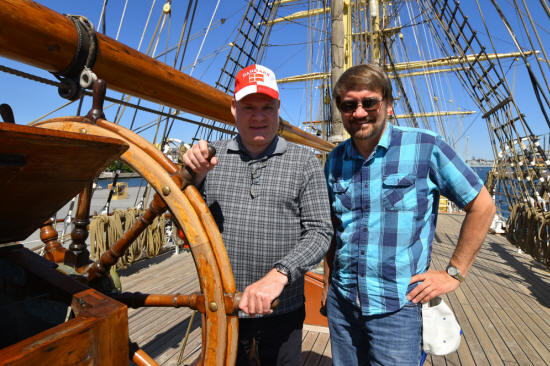 Producer Randy Gitsch & Editor Dave Strohmaier
on board the "Sørlandet" in Copenhagen, 24. May 2018. Picture:
Thomas Hauerslev Producer Randy Gitsch & Editor Dave Strohmaier
on board the "Sørlandet" in Copenhagen, 24. May 2018. Picture:
Thomas HauerslevOn the occasion of Cinemiracle and Cinerama screenings in Copenhagen, May 2018, "The Cinerama Archaeologists", (Producer Randy Gitsch and Film Editor Dave Strohmaier) were in town for a few days to introduce the films and talk about their work. I captured them on a sunny day by the harbour in front of the Norwegian windjammer "Sørlandet". A 45 min. lunch chat about their work, looking back at all these years of remastering all five Cinerama travelogues, ”Windjammer” in CineMiracle, remastering five short films, one Smell-O-Vision title, one lost Technirama film, reconstructing one Cinerama compilation, as well as saving the "Russian Adventure" - and MUCH more. Since this endeavour is now in its final stages with the release of "The Golden Head" on BluRay early in 2019, I thought it was time to look back at their achievements, which started nearly 20 odd years ago during production of the documentary "Cinerama Adventure". Thomas Hauerslev: How did all this Cinerama work come about? Randy Gitsch: Our success in achieving what we have done came about because we have a documentary we made called “Cinerama Adventure”, which David started and he and I together finished. It broke ground for us and Cinerama in many ways. I had previously produced a documentary [“Keepers of the Frame”] on film preservation and it included a small bit on Cinerama and John Harvey, but more importantly I learned how to be a film producer and how to raise money for film making. Because to get on bended knee and ask for people’s assistance and support, it’s very hard to do that for a documentary film that is going to be purely entertainment. It is a little easier to do that for something that has an educational goal, or is trying to achieve a public good, change public opinion or to illuminate history. I succeeded doing that on my doc. in 1999, and I brought that skill to our partnership making “Cinerama Adventure”. Because of that, we got services in kind. We got the donation of services for example, let us say, to license stock footage for just a dollar, and we also got the full-fledged support of groups and, in one case, the use of their logo. The American Society of Cinematographers support was really substantial, as it stamped us with an official approval, showed that we had been vetted, and that people understood what we were trying to achieve and agreed with our goals. So that really got us kind of past the starting line with getting things going. • Go to Theo Gluck and the Interest in Movies - A Master Class in Film Restoration THa: How did it evolve into actually taking the negatives out and finally seeing them back in cinemas? David was mentioning that, because he had been contacted by Paul Allen about making a film about Seattle - which eventually turned out to be “In the Picture” in Los Angeles - somewhere in between there must have been a decision on “why don't we go for the old inventory and remaster them”? Randy: Dave had to get clips from several of the Cinerama films for “Cinerama Adventure” so he had dabbled in those pictures to begin with, and scanned segments of them and so Dave was kind of, I'm sure, turned on by the mystique and the tragedy and the potential of that stuff. Dave was immersed in Cinerama before he had any plans to restore anything. That was the link. That was the impetus to him getting involved enough to say that “Gosh, maybe we really should restore these pictures”? -, and from that inkling, he turned that into an appeal and Michael Forman [Pacific Theatres Entertainment Corporation and owner of Cinerama assets] responded to that appeal. |
More in 70mm reading: Die Cinerama-Archäologen Theo Gluck and the Interest in Movies - A Master Class in Film Restoration Copenhagen Cinerama Introduction Gallery: CineMiracle at the Cinemateket, Copenhagen Dave Strohmaier and Randy Gitsch - in conversation with Mark Lyndon Cinerama, Dave Strohmaier and the "We have all seen it as a kid" thing Interview with producer Randy Gitsch "The Wonderful World of the Brothers Grimm" Remaster Trailers Restoration and re-mastering “The Wonderful World of the Brothers Grimm" from 3-strip 35mm negatives Interview with Mr John Sittig of Arclight - The Dome, Hollywood, Los Angeles Remastering the CINERAMA Library Louis de Rochemont's "Windjammer" produced in Cinemiracle in70mm.com's Cinerama page |
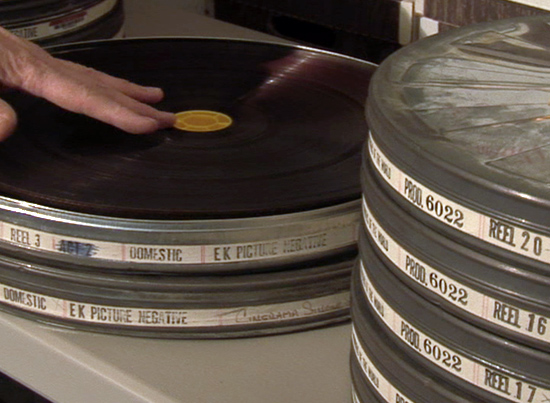 Dave Strohmaier: We are half way through it [“Cinerama Adventure”], and then I get this call from
Paul Allen's [co-founder of Microsoft] people. Having heard about the
documentary, they figured that this guy kind of knows where all the bodies
are. A guy called Jeff Graves who worked for Paul Allen came down to visit me two or three times.
"What is it taking to restore all this?" He figured that I knew
enough about it to be dangerous, so that he would ask me before he would
approach the Cinerama company. Then Jeff and I would go to meetings with
people at Pacific Theatres, the successor and heir to all things Cinerama, and say we want permission to restore the movies. Now,
I am not a film restorer by profession, I am a film editor. I didn't know anything about
film restoration, so I contacted a friend of mine, who worked at Disney for
years, named Leon Briggs, and who had a film consultant firm and he had restored
movies. I think he did the first pass at “Star Wars”. So he got involved, and
then we went to Paul Allen's company [Vulcan Northwest] and approached them. Here is what it
is going to cost - we think. We are not sure, but you have be flexible and all
that kind of stuff. Then there was this constant string of delays and
nothing happening. So then we just kind of, “wow we don't have that kind of
money to do anything”! We couldn't do anything. Then
John Sittig actually went to Michael Forman
and said
"You better start preserving
these negatives or scanning them or something, because it is not going to last
much longer". I had warned them a year before that, so they had several
warnings. Finally it hit the top echelon guy who could do something about
it and he authorized a certain amount of money. That was basically
an account that was created, that I was in charge of. Now, I am not an
accountant by profession either, so besides not being a film restoration guy, I was in charge of
budgeting this whole thing. And that was when I found this company
called Image Trends. Dave Strohmaier: We are half way through it [“Cinerama Adventure”], and then I get this call from
Paul Allen's [co-founder of Microsoft] people. Having heard about the
documentary, they figured that this guy kind of knows where all the bodies
are. A guy called Jeff Graves who worked for Paul Allen came down to visit me two or three times.
"What is it taking to restore all this?" He figured that I knew
enough about it to be dangerous, so that he would ask me before he would
approach the Cinerama company. Then Jeff and I would go to meetings with
people at Pacific Theatres, the successor and heir to all things Cinerama, and say we want permission to restore the movies. Now,
I am not a film restorer by profession, I am a film editor. I didn't know anything about
film restoration, so I contacted a friend of mine, who worked at Disney for
years, named Leon Briggs, and who had a film consultant firm and he had restored
movies. I think he did the first pass at “Star Wars”. So he got involved, and
then we went to Paul Allen's company [Vulcan Northwest] and approached them. Here is what it
is going to cost - we think. We are not sure, but you have be flexible and all
that kind of stuff. Then there was this constant string of delays and
nothing happening. So then we just kind of, “wow we don't have that kind of
money to do anything”! We couldn't do anything. Then
John Sittig actually went to Michael Forman
and said
"You better start preserving
these negatives or scanning them or something, because it is not going to last
much longer". I had warned them a year before that, so they had several
warnings. Finally it hit the top echelon guy who could do something about
it and he authorized a certain amount of money. That was basically
an account that was created, that I was in charge of. Now, I am not an
accountant by profession either, so besides not being a film restoration guy, I was in charge of
budgeting this whole thing. And that was when I found this company
called Image Trends.Meanwhile the documentary got finished and started going around the world, which created awareness for the old films. So it was one of those things, where once it got rolling, then it kept rolling up the hill, or at least staying level. I would have to authorize a certain amount of money for this and a certain amount of money for that, such as the scanning. I contacted a number of scanning companies, and of course in those days (around 2009 or 2010), all the scanning companies said … “Well, it's 1$ a frame”, or some ridiculous amount of money. You will never be able to do anything, and no one understood about the 3 panels and the 6 perf. They have to re-work all their equipment, to make 6 perf. If you are Paul Allen then you can do it, but meanwhile they were still laying silent in Seattle and not making any decisions on that or anything. Therefore, we contacted this company called Image Trends and I think they were in a downturn or something, because they said “We will do it”. It was almost like these visual effects companies now, when you are doing all these comic book movies, with all the effects and the Empire State Building collapsing and everything. It is like they will underbid stuff, and later they will try to get more money out of you. I had told this company that we had this amount of money, can you do this type of job, but we are in no hurry. We just want to get it done. Half of them had seen Cinerama as kids, so now it became an emotional issue. Now they were going to do anything for pennies on the dollar. But I am the guy that had to sell all this to everybody, and tie all the things together with a bow and get this company to work extra cheap and that sort of thing. And then I had like 70.000 $ left over as a cushion, figuring that there will be trouble down the line, and I have to borrow 10.000 $ here and something there and whatever. Then we decided to shoot a movie in Cinerama [laughs]. 15.000 $ went for the restoration of the camera, it multiplied from there, but everything balanced out. Got everything done, and I was 6.000 $ under budget. That was for the four travelogue titles and the two “This is Cinerama” and ”Windjammer”, the first pass, which was not from the best material. So then everything was closed off and then I get a call from David Coles and John Mitchell who said “Oh, Dave what are you going to do next? Why don't you do – "Best of"”? Well, there is no money left, we have shot it all. And then was when people started saying “Well, how much is it going to take”? So I go to FotoKem and talk to Andrew Oran. "Can you do 6-perf? Is there a way to do this inexpensively without the mechanical scanning, but doing a telecine kind of Spirit scanning, which is from what I can see, exactly duplicate of other scannings?" It doesn't bother me at all, that we went that route. Well, then people started getting us money to get it done. People were putting money into this, and all I did was to do my part of the job for free. Then they would send money, not to me but to FotoKem, and there would be an account set up. Every time we scanned, they would deduct from the account and they would let me know when I was on my last 1000 $. Then someone would call me up and say "So is it done now? No, we are actually going to need some more money". We contacted the Norwegians, to see if they wanted to put money into ”Windjammer”. It was kind of their movie and that went on for 6 months and nothing happened, but then one day a guy called me up. I'm not going to mention his name because he wanted to be anonymous. He said "What are you going to need to finish ”Windjammer”?" and I said, it could be like 15.000$ and he said "Where do I sent the cheque?". He is not going to make any money off of it. I'm not going to make any money off of it. Randy is not making any money. No one is going to make any money, but we got it done. And that was sort of the conclusion of it, finishing up ”Windjammer”. Same thing happened with "Russian Adventure", someone paid for that. |
|
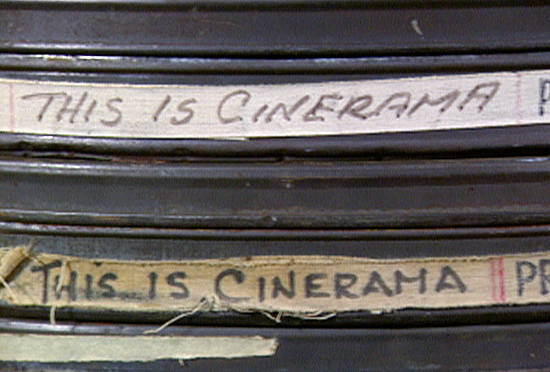 Randy: Dave responded to Paul Allen with his proposal to make a
short film similar to what we eventually made, called "In The Picture",
but which would highlight the most picturesque hot spots in Seattle or
things close to the Seattle Cinerama Theater, but they ultimately did not go
ahead and do it. But the shooting concept script was still there, in Dave's head.
Once you first light a fire under yourself, you get yourself a hot seat, you
have a lot of motivation to really tear into something and get something
accomplished, one way or the other. That residual energy resulted in
our making “In the Picture”, touting the Cinerama Dome Theater in Hollywood.
As Dave said, our ally John Sittig told Michael Forman he really should do
something. Michael Forman wanted to do something. I think probably he
realized his father's legacy was an integral part of Cinerama, even though the company
had lost millions of dollars on Cinerama in the sixties. So there would be
no company contribution to this project. Forman’s theater company does not
want to again be a film production company. It hadn’t been a production
company for many, many years. It hadn’t been a distribution company for many
years. So the theater company didn’t have a vested interest in preserving
that work, which is why Michael Forman was willing to put up that money,
himself. Michael Forman, by the way, also wished to remain anonymous. He
originally had his name on some of the early re-master credits on IMDB for
example, but he ultimately did not want to be credited. Randy: Dave responded to Paul Allen with his proposal to make a
short film similar to what we eventually made, called "In The Picture",
but which would highlight the most picturesque hot spots in Seattle or
things close to the Seattle Cinerama Theater, but they ultimately did not go
ahead and do it. But the shooting concept script was still there, in Dave's head.
Once you first light a fire under yourself, you get yourself a hot seat, you
have a lot of motivation to really tear into something and get something
accomplished, one way or the other. That residual energy resulted in
our making “In the Picture”, touting the Cinerama Dome Theater in Hollywood.
As Dave said, our ally John Sittig told Michael Forman he really should do
something. Michael Forman wanted to do something. I think probably he
realized his father's legacy was an integral part of Cinerama, even though the company
had lost millions of dollars on Cinerama in the sixties. So there would be
no company contribution to this project. Forman’s theater company does not
want to again be a film production company. It hadn’t been a production
company for many, many years. It hadn’t been a distribution company for many
years. So the theater company didn’t have a vested interest in preserving
that work, which is why Michael Forman was willing to put up that money,
himself. Michael Forman, by the way, also wished to remain anonymous. He
originally had his name on some of the early re-master credits on IMDB for
example, but he ultimately did not want to be credited.Dave: It was ok to say “Thank You”, but they did not want "Producer - Michael Forman" credited that way. Randy: A couple of things to add to all of that - timing is everything. The big event that helped us achieve our goal was that the cost of scanning, at the time we were doing this, was undergoing kind of a quantum leap price point drop – in the U.S. "charging dollars per frame" was becoming more like "charging frames per dollar" and becoming the new norm. That greatly increased the affordability of digital scanning. And then Michael Forman made his generous gift, and you know no one ever wants to be the first, but everyone wants to be the second. Because it further legitimized us and people could see an obvious accomplishment in some of our early tests, so they wanted to be part of it. "Saving what? – Is there any more to save?" and that was the big appeal for people who came forward. They literally came to Dave – Dave didn't exactly hang out a shingle or send word out that we needed money to get this done, but it got done from the contributions of people, just individuals, starting with Michael Forman. Neither “Cinerama Adventure”, nor “In the Picture” nor any of our digital re-masters were ever a GoFundMe – or a Kickstarter appeal. We were never funded like that. We proceeded in good faith and based on the merit of the subject matter. When Dave and I partnered to do "Cinerama Adventure", I had already done the documentary that was about film preservation, so I had already taken that pro-film preservation path, realizing that there are films that are pure entertainment and they certainly have value, and we love entertainment films. That's what most films are and we love them and we want to save them, but we also like documentary films. Quite honestly you have to educate people, and I had educated people at that time about film preservation. And we had to educate and re-educate people about Cinerama in order to preserve it. Dave: The American Society of Cinematographers added extra gold around our names. "Oh, you are with those guys?", you know. They didn't put any money in it either, but they made contacts for us. They called Kodak, they did all kinds of stuff, way above and beyond the call of duty. Two crazy guys making a documentary. "What do you need? How can we help?". And it is certainly welcoming to hear that kind of dialog when you are on the phone! |
|
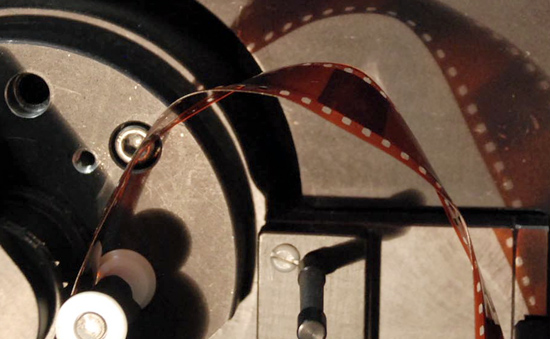 THa: What has been the biggest obstacle with all this? THa: What has been the biggest obstacle with all this?Dave: With film restoration when you are not a film restorer, there is always the obstacle of "How do I fix this?". That can be an advantage too, because I am not stuck in a conventional thing where "This is the procedure, Dave, you can do this, this and this and it costs 40.000 dollars". You go at it with an attitude of how did this happen and you call all around and you seek ideas from people. I contacted the guy that sets up all my computer systems for editing and he said: "Ohh, I think I can help you with that" and he said, "You need to order this program, and that program and try this one too and blah, blah". These were off the shelf programs that were not really for restoration, but you can apply it for that. Philip Hodgetts, who gets credit on all our shows, said "...but you can use it for that". So I just went in and blindly, stupidly, whatever, got it on my system. I have got a high end computer at home. It can practically do anything. So I would try some of these things and a lot of experimenting and a bit of a learning curve and I was finding that it could do what the big boys are doing. But a lot, lot cheaper. That you can take something like "Windjammer", an make it look like it looks now for 17.000 dollars. They should be embarrassed. THa: Any comments from the producers side? Randy: I can tell you that a few years ago and under a big roof, let's say a big Hollywood studio roof, for example, restoring a triptych like this would have cost over 1 million dollars per title. Now the decimal point has moved several spaces to allow us to get it done. As I said earlier, what really helped was that quantum leap in the affordability of digital scanning which was billed in “dollars per frame” until it became “frames per dollar”. Dave: And at one point it was so much per foot and now it is "How much per hour?". But it does help to have people who are understanding. They have to make money too, like FotoKem, but the reason I didn't charge any salary, first of all I couldn't, for all the money should go to scanning, but my motivation, as it were, was more on the side of "I started this project, we did so many restorations, let's do the rest of them". All we needed to do was to get the scanning money available and buy a couple of hard disks. The rest of it was basically free labour. That includes Randy, Tom March, who does all our DCP's and some of the restoration. And then the stuff that I do, you know, all of which is to finish off the legacy. Being semi-retired, why would I stop and leave two titles dangling? You might as well finish them and then close the book on everything. Of course, that leaves Warner Brothers with "Brothers Grimm" to do [laughs]. • 2022 update: Restoration “The Wonderful World of the Brothers Grimm" from 3-strip 35mm negatives • "The Wonderful World of the Brothers Grimm" Remaster Trailers |
|
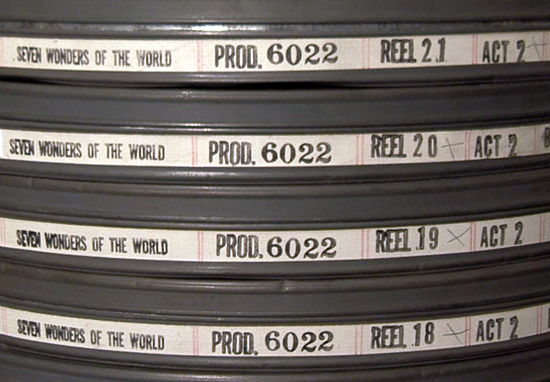 THa: What has been the biggest surprise in all this work? THa: What has been the biggest surprise in all this work?Dave: That “Windjammer” came out as good as it did. And that the obstacles we had on “Seven Wonders” were pretty close to that. Same with “Russian Adventure”, but “Windjammer” looked like it just wasn't going to get done. I mean, half way through it was like, "maybe we should just give up now", because of all the horrible stuff we had to deal with. And then, lo and behold, just experimenting with something, getting rid of the horrible blotches which were in all the positives, was like "What! You can actually get rid of that?". There was no logic as to how it worked. It was just certain software would do certain things and then if you process it again with the other software it will take care of this other thing. So it becomes a point where you are looking at your computer and you can't believe what you are seeing. "It can actually do that?" I wonder if the big boys know this! [laughs]. Because every restoration I have seen, almost all of them anyway - they are certainly photochemical - I see nothing but flicker. I am sensitive to flicker now. I see a "Laurel and Hardy" short being restored or I see some other classic thing being restored and I'm looking at it and I am seeing dirt go by and stuff like that. And I think, how can they call it restored? Remastered maybe, but look, that flicker is the easiest thing in the world to get rid of. It will take an hour to render part of that reel and the next morning it will look great. "Why didn't they ....?" That is my constant frustration, so I have trouble going to see other restored movies. Not that I am "The King of the Hill", but the fact that THEY DIDN'T EVEN DO THAT? And they had money! [laughs] Randy: The big surprise for me was how entertaining the Cinerama films still are. They are very much a time capsule, which is fascinating to most people. Both for people that are from that era, as well as people that are born outside that era. It's a perfect capture of reality, but that's what it is in more ways than one. It's not just real widescreen drama, its actually real people the way they really talked, thought and acted at that time. I think it is a fascinating library of motion picture history. Dave: It is really an archive of images in a way, because it is not for everyone. In the 50's and 60's it was kind of for everyone, but now, with the young people and their devices and all that stuff, you know, it's like they wouldn't be able to handle it unless you have a sense of history. You are brought up in a certain way and you realize that that was my grand father's time and that is probably what he would do, if he went on this boat at Cypress Gardens or something. That's the way I always looked at things when I was a kid. You know I thought that certain things were fascinating. "Ohh we are going down into the pyramids or we are doing something archaeological?" That was interesting to me, as opposed to the Empire State Building collapsing with a comic book hero holding it up, for example. Randy: Well too, we all have to remember that Cinerama appeared at a time when people were just becoming affluent enough to have the ability for some leisure travel in their lives. Prior to that people did not have leisure travel, they certainly, rarely, if they did travel, it was rarely on an airplane, so something like an aerial view of something was absolutely fascinating. For people who had never been out of their home environment, their home city, their home state their province or whatever, the rest of the world was utterly fascinating. It was wonderful and strange and different - and Cinerama took you to these places and you got to have a luxury experience of travel by watching these films. THa: What has been the biggest pleasure of doing all this work? Randy: There have been a lot of pleasures. Certainly, it has not been a financial pleasure [Dave laughs]. We have not been rewarded in any real financial way. I have travelled with these films, which is a sweet irony, because Cinerama had a worldwide legacy. It is still popularly received around the world, as it is right now in Copenhagen, by new generations who may not have experienced it, but they can see their community, their city, their nation, you know, visit it, at a time when Cinerama was in its heyday. So yes, being able, willing and invited to travel for Dave and I, has proven itself a wonderful thing, to be able to share these films at screenings. To detail our film, the Cinerama process, remastering workflow and tell the history of Cinerama and these pictures kind of "on the road". Another thing that has been a pleasure for me personally is meeting some of the surviving crewmen, production crew and actors, or in case of ”Windjammer”, the sailor trainees. They all have back stories about these films, sometimes the most wonderful experiences, whether they were on a sailing vessel, whether they were an actor, or if they were just in a scene or two. These were often once-in-a-lifetime experiences for them, and to meet them, and to hear their stories is fascinating. Dave: I think the biggest pleasure for me is showing it to people and probably, in my case, it's when you have a big crowd watching it and you can sense that the audience is "into it". I have had the same kind of experience with my editing work, as well. I would do a movie pile and go test it with members of the public. The network will get a bunch of, maybe a hundred people, and you look at your work through the eyes of other people and you will see them reacting to certain things and it makes you watch the movie with almost new eyes. It's like your first time too, because you finally are getting feedback on the months of work. Same way with restoration, probably the biggest thrill is when I run it for people in my house and invite like the head of restoration from Disney over and a few of these other people, like friends and Randy. There is a tight knit group – "Oh, Dave is going to run something tonight, let's all go to his house, and he always orders pizza" and show it for them, because they are kind of the critical test audience. And see if they noticed the part where…. "Oh good you did not notice that problem". Or "Oh, I will work on that one again and try to fix it better". So it is a little bit of feedback. Those to me are pleasurable. |
|
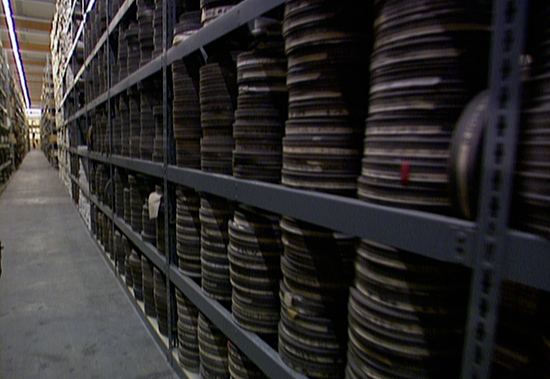 THa: Where did you find all the negatives and sound? THa: Where did you find all the negatives and sound? Dave: Well it is all over the world, practically, in a way. The only reason we could restore ”Windjammer” the way we did is we found a bunch of boxes that had no labels on them, as we were searching through the old Cinerama vaults, which is in North Hollywood. We found this box and I opened it and it looked like a scene from ”Windjammer” on Able panel or Charlie panel, but it had color. Because an interpositive is really a positive image even though it is on a negative film stock, so to speak. So I said "Wait a minute, were did this come from?" And then we had to inventory all this stuff. So way before you start scanning, you inventory everything you have, to see if you have a complete movie. And if you do not have a complete movie, then you can go to the Library of Congress, which we knew through Larry Smith, from the New Neon Movies, who works there now. He said – "We have the 3-panel print, which is pink, so you can default to that". The negative is not always beautiful and not all there. It is always in horrible shape, with reels missing over here, something is missing here and something over here, because it was not handled right over the years. It was not in a studio vault, which would have probably have kept track, even though there are problems at studio vaults as well, like "Brothers Grimm". But it becomes a jigsaw puzzle, lining up every shot. You have to inventory every single cut in the movie, what the description is: the sailor walk from left to right and they get on the ship. You have all these things numbered. That's why there are 437 in ”Windjammer”, times 3. And you have to inventory all this and create giant charts with all this – where do I get this shot? Because that one has the missing scene? Or they cut the scene in half. This can get complicated. Then, they make it even worse: ”Windjammer” did the single panel version, similar to “Seven Wonders”, and they did it off this IP. They were cutting from the Baker panel to the Able panel and back over the C panel. It was because they were creating a 4 perf version from a 6 perf source, you have to cut it out of frame. So you lose the top or the bottom of the image. Now you have to replace with something right? It was all over the map, so it was more than a jigsaw puzzle, the sides coming from 3 different elements. And the default last and final default element would have been the old transfer, for whereever there was something missing. Which would, of course, have hit like night and day between the grain and the funny color. But it did not happen, everything was available, everything came out of 6 perf material. Whether it would be Library of Congress faded print with color rebuilt back in, or the IP with all the blotches we removed or the original negative. The whole navy sequence is from off the original negative. Because the other thing about 3-panel footage, is when it is shot in bright daylight area, it holds up better than it is shot in twilight. It starts deteriorating faster. I don't know why, there is probably an explanation for that and I don't need to know it, but it just is. So we were able to take the whole navy sequence from the negative which, would then require more work, because it had more wear and tear, more dirt, more use. As many people already know, every single print that went out to the theatres on Cinerama or the Cinemiracle movies was struck off the original negative. So if they made 300 prints of “Seven Wonders”, they were all struck off that original negative, so there is more wear and tear. And then you have to clean that up. They wanted first generation on every screen, that's why. |
|
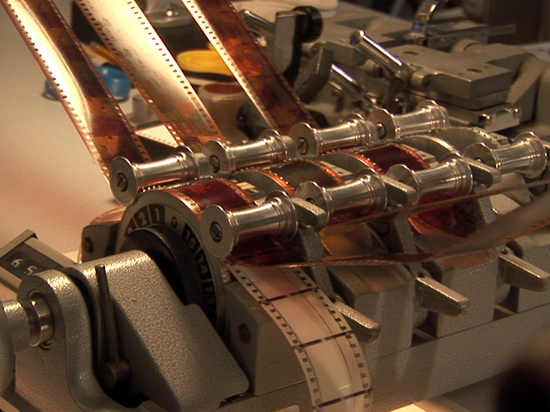 THa: There were never any protection masters made? THa: There were never any protection masters made?Dave: There were YCM masters made of the Cinerama travelogues, but they were made at a time when you made YCM's - I believe is was mid or late 50's - when if you didn't do it right, it ended up worthless. Leon Briggs said some were made in a year where YCM's were done correctly, because "Joe Blow" was in charge of doing them, but then sometimes by his assistant, who wasn't that good. So they may end up with two Ables and not enough C's and plus one of them was black and white. So there you end up with nine pieces of film that would make one frame of Cinerama. And that is nine things that can go wrong, when you go from YCM masters. But it was their policy, like it is at the studios, that you make YCMs of everything as a preservation for the future. And they did that with Cinerama. But they never made YCMs with ”Windjammer”. THa: In what state were the negatives and sound elements? Dave: Sound elements was completely warped mag films, 7 channels on the giant reel, just like the release prints. Chace Audio, in 1999 when Gunther Jung was still involved, we had them baked and transferred over to 24 track, which then had to be transferred later over to digital. So that was the preservation. That was the first preservation we did. They didn't have ”Windjammer”, or it was too warped to use. So John Mitchell [Sydney, Australia] provided the ”Windjammer” soundtrack in order to string it off into the 7 channels. Then later on, hopefully, someone would restore these and they would have useful elements in the vaults. So that is how we got the soundtracks, a little bit of a worldwide effort in a way. Randy: A lot of the film cans, had “Run Backwards” stickers or “Run Reverse” stickers on them. That is a sticker that labs put on high-traffic film material, film elements that had been run through a printer so often that many of the sprocket holes had broken off on the drive side of the film. Now “Run Reverse” means that you flip the film and go tail to head, meaning a different orientation through the machine. The problem with the Cinerama material was that a lot of these same elements had sprocket hole damage on the "reverse" side of the film as well. So in addition to being extremely faded and shrunken, they were suffering the vinegar film syndrome, they had edge weave, they had warping, they had spoking, they had old anti-scratch coatings that Dave had to remove and they had very tired perforation holes! They really were elements that film archivists like myself would call “junk”. I want to add that the Cinerama library was for most of it's life stored in a vault that was only built to the pre-ANSI standards for film storage of that time. Unfortunately, this was nothing like PRO-TEK Vaults, where I work today. Temperature and humidity levels were not within contemporarily approved ranges and the Cinerama films suffered because of it. |
|
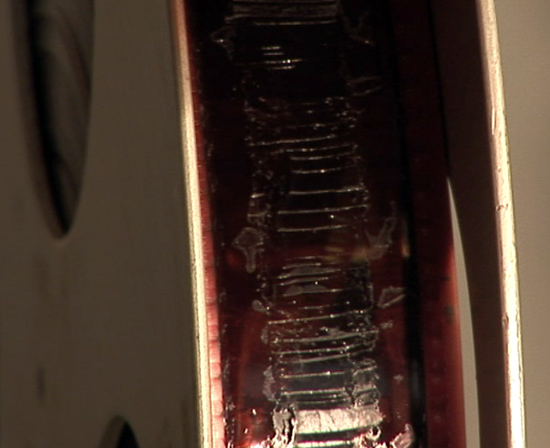 THa: What's the biggest find you have ever discovered in the archive? THa: What's the biggest find you have ever discovered in the archive?Dave: There are two things. First was the IP's that we found for ”Windjammer”, and the other was “Tale of Old Whiff”, which is a cartoon that was in a box that wasn't labelled. Obviously, if you going to do this, the first thing you should do when you go in to the vaults, is open up all the boxes that don't have labels on [laughs], which we did. "Oh here is "Seven Wonders" let's pull that". Yes, open all those boxes, because you never know what you are going to find in there. Forrest Gump's a box of chocolates: "You never know what you're gonna get". THa: Where do all these elements go, when this job is all completed? Dave: Everything that I have finished with, they held it at FotoKem, because it was all ultimately to go to the Academy Film Archive, which means it would go under cold storage. Everything that I dealt with, they had to hold on to until I was completely finished with everything. So I had to tell the Academy when they could pick up a certain film or this batch of cans, because now I am completely done with that stuff. So everything went over there. Randy: I think the single most important thing, that we did, was rediscover the “Tale of Old Whiff”, because it truly was a lost film. It was a lost film even to Cinerama. We are not sure that Cinerama even exploited the picture after they acquired possession of it. And it was the first 70mm animated, color cartoon, and originally presented in "Smell-O-Vision", so it got a lot of firsts. THa: Was it a negative you found or a positive print? And how about sound and all that? Randy: They found a positive print and it was faded, but Dave was able to get the color out of it. And what was the sound source of that? Dave: It was on the print. It was 6 channel, regular 70mm magnetic stripe on the print. THa: What kind of industry response have you met with all this work? Randy: I am a film archivist and I think fellow film archivists have to be in a bit of awe about our accomplishment. I think many of them are aware of the cost differential and the price we have paid get to the ends we have achieved. I think the studio end of things is probably a little more resistant to that approach. They have kind of an in-house infrastructure that works on a little different principle and costs a lot of money. And, I don't know, I would like to think that in some ways, some day, perhaps sooner than later, the studios will come around to realizing that there may be another, less expensive way to do these things. Dave: Before I did my semi-retirement a few years ago, I always thought – "Hey, if you can do this on your home computer, what about all those films that are not that important to the studio?". When will they farm it out to people in their garages who have computers, that can at least do a 2K version of something, which is really all you need for a 1,33:1 movie, as far as I am concerned? And that will even hold up theatrically, unless it is Imax. But at least preserve those, using the same software I use and you can get a bunch of stuff done. Yes Mr. Studio, do your "Gone with the Wind"s, do your "Mary Poppins" and spend the time and the money and effort. But all those little things, that you are never going to be able to touch, you can still get them done for nickels and dimes. |
|
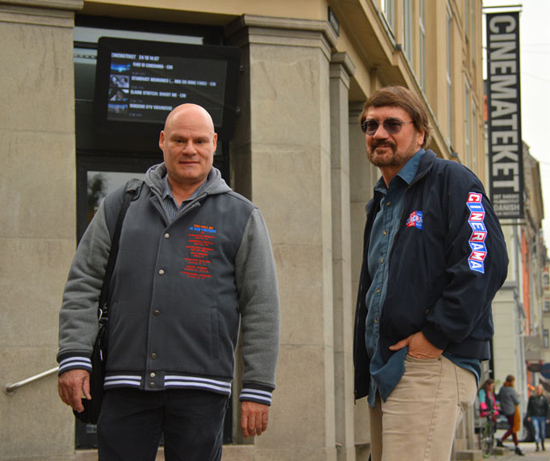 Randy Gitsch & Dave Strohmaier
in Copenhagen for the "2015 European Cinerama Festival Tour".
Picture: Thomas Hauerslev Randy Gitsch & Dave Strohmaier
in Copenhagen for the "2015 European Cinerama Festival Tour".
Picture: Thomas HauerslevTHa: What kind of response have you got from the fans? Dave: It is always good. We screen Cinerama at the Dome periodically and fans would come out of the woodwork and attend. But you really have to publicize these things way ahead of time to get people to come out. I can't tell you how many times we have done something at the Dome or someplace and two days later someone calls me up and tells me – "What was that at the Dome? No one told me about it". And I say – "Where were you?" – "Oh, I had to change the air on my bicycle tire that night". To me, you cancel that bicycle tire work and you go and see "How the West Was Won". Randy: You know – fans are always going to appreciate the films. The bonus that they get – I guess now from being a fan of Cinerama - is that they were all denied the films for so long and now they can kind of – like coming off a diet or something. You can finally have a pizza again and they love having it. Not only that, you can buy your own personal DVD or BluRay copy of them. So it is a double whammy of a benefit to be a Cinerama fan right now. Dave: And so many people have told me that they do two things. Everybody is getting home theaters now with bigger screens and all that sort of stuff. They lay right in front of their front panel or TV screen and they put their sound up and pretend they are in a cinema theatre, which you can do with our shows, because we have curtains and all that. It was one of those things where you get to experience it at home. And you can also flick your 3D switch on and get "3D" out of Cinerama. Some people had said "Oh, have you seen it 3D yet?". So I went over to a friends house and we put on 3D and YOU DO get 3D! It is not real 3D, and you have to have the glasses and all that stuff, but you see more of a curved screen, you get a little extra jolt out of it I guess. But they are just amazed. Like we designed it that way. But we didn't - it was an accident. THa: How do you see this coming to an end, and what can we expect in the future – like “The Golden Head” and “Brothers Grimm”? Dave: I think basically the work is at an end, and now it is a matter of doing screenings and stuff like that. I think what we have done is good set-up work. None of these movies are restored what I'd call perfectly, there are areas where the colors are a little funny and you can never get flesh tones across 3 panels and get it equal. You have to go for skies and big things like grass and stuff, but I would say it is kind of a thing where, in the future, if someone wants to take these master files - and we have preserved the master files through a company called Digital Bedrock, and which will migrate [= preserve] them over the years - someone could come in, probably with some newer software, and fix things that we could not fix. Some of the funky color that is still here and there. So it may not be over and maybe I will be the guy that does it, but then there has to be a demand for these films and that sort of thing. So I think we have done about all we can do right now. And “Golden Head” will come out sometime in 2019 and that was restored 4-5 years ago. So that has been done for a long time. That was the easiest restoration in the universe. It was in excellent condition and had all its color. The only thing left is “"Brothers Grimm", which is in a shambles and they know that at Warner Brothers, and that is probably why they don't want to attack it. I am not sure I blame them. Randy: Seeing Dave succeed in bringing an entire company's widescreen, namesake legacy library back from oblivion, and me being able to re-copyright on behalf of Cinerama, Inc. these newly re-mastered versions, has been the most rewarding return for our endeavours. We have made these titles commercially viable once again. I think we probably are at the end of our process because we have completed the library, but what I would like to see is many of the rest of the motion pictures that were ”Presented in Cinerama”, on the big curved-screen. They may only be in Ultra Panavision, but a lot of those pictures could be remastered and Smileboxed, and they can then be shared with new consumers, once again. I think that there are several forgotten films in that oeuvre – one that interests me the most is “La Fayette” the 1962 French film, at the time the most expensively lavish film ever made in France, which was presented in Europe ”in Cinerama” on curved screens. That is just one example of many that I think should be tackled and rediscovered. • 2022 update: "The Wonderful World of the Brothers Grimm" released on BluRay from Warner Archive |
|
| Go: back - top - back issues - news index Updated 22-01-25 |
